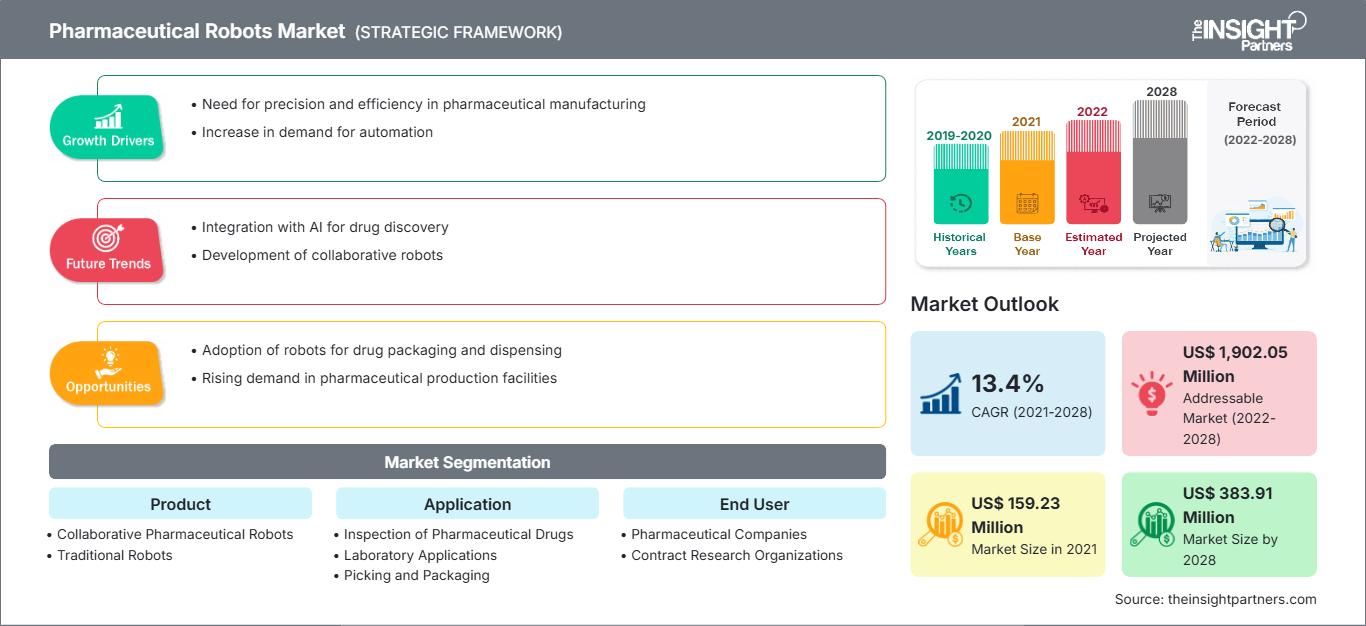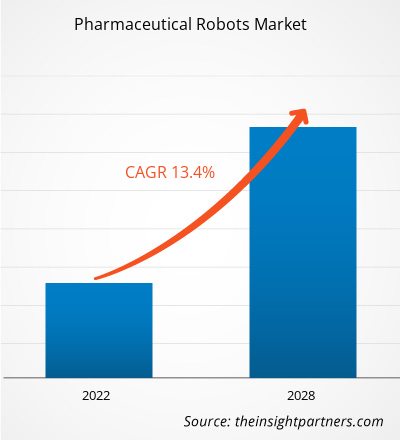[Forschungsbericht]Der Markt für Pharmaroboter soll von 159,23 Millionen US-Dollar im Jahr 2021 auf 383,91 Millionen US-Dollar im Jahr 2028 anwachsen; von 2021 bis 2028 wird ein durchschnittliches jährliches Wachstum von 13,4 % erwartet.
Die Pharmaindustrie benötigt effiziente und präzise Produktion von Arzneimitteln. Der Einsatz von Robotern in der Arzneimittelproduktion verbessert daher die Qualität und reduziert Kosten und Zeit. Roboter erweisen sich als vorteilhaft in der Abfüllung, Inspektion, Verpackung, in Laboren und bei der Herstellung personalisierter Medikamente. Ein Robotersystem ist ein Automatisierungssystem mit mehreren Bewegungsachsen, das für die Ausführung beliebiger Funktionen programmiert werden kann.
Der Bericht bietet Einblicke und eine detaillierte Analyse des Marktes für Pharmaroboter und legt dabei den Schwerpunkt auf verschiedene Parameter wie Markttrends, technologische Fortschritte, Marktdynamik und eine Analyse der Wettbewerbslandschaft führender Marktteilnehmer weltweit. Er berücksichtigt auch die Auswirkungen der COVID-19-Pandemie auf den Markt in allen Regionen. Die Auswirkungen der Pandemie und die abnehmenden globalen Forschungsaktivitäten haben auch die Geschäftstätigkeit und die finanzielle Leistung mehrerer Unternehmen im Markt für Pharmaroboter beeinträchtigt. Die Weltorganisation für Tiergesundheit (OIE) unterstützt die Forschung bei der laufenden Forschung und anderen Auswirkungen von COVID-19 auf die Tiergesundheit und die öffentliche Gesundheit von Geflügel. Die Organisation unterstützt auch bei der Risikobewertung, dem Risikomanagement und der Risikokommunikation. Zur Koordinierung dieser Aktivitäten hat die OIE ein Vorfallkoordinationssystem eingerichtet. Darüber hinaus haben die COVID-19-Pandemie und die daraus resultierenden Lockdowns die Vieh- und Geflügelwirtschaft in verschiedenen Ländern weltweit erheblich beeinträchtigt. Die Lücke zwischen Angebot und Nachfrage dürfte sich mit der Öffnung der Marktketten und zusätzlichen Maßnahmen der lokalen Behörden zur Beseitigung von Engpässen in den Liefersystemen allmählich verringern. Es wird zudem erwartet, dass die Auswirkungen langfristig anhalten und erhebliche Auswirkungen auf den Lebensunterhalt, die Beschäftigung und die Gesamtwirtschaft der Branche haben werden. Der Markt für Pharmaroboter ist nach Dosierung, Krankheit, Technologie und Region segmentiert. Der Markt ist regional in Nordamerika, Europa, Asien-Pazifik, Naher Osten und Afrika sowie Süd- und Mittelamerika unterteilt.
Markteinblicke
Passen Sie diesen Bericht Ihren Anforderungen an
Sie erhalten kostenlos Anpassungen an jedem Bericht, einschließlich Teilen dieses Berichts oder einer Analyse auf Länderebene, eines Excel-Datenpakets sowie tolle Angebote und Rabatte für Start-ups und Universitäten.
Markt für pharmazeutische Roboter: Strategische Einblicke

-
Holen Sie sich die wichtigsten Markttrends aus diesem Bericht.Dieses KOSTENLOSE Beispiel umfasst Datenanalysen, die von Markttrends bis hin zu Schätzungen und Prognosen reichen.
Cloud-Robotik ist ein aufstrebendes Feld der Robotik, das auf Cloud-Computing, Cloud-Speicher und anderen Internettechnologien basiert und sich auf die Vorteile konvergenter Infrastrukturen und gemeinsam genutzter Dienste konzentriert. Die Anbindung von Robotern an die Cloud erhöht Rechenleistung, Speicherkapazität und Kommunikation. Cloud-Roboter kommunizieren miteinander, sodass Operationen einfacher ausgeführt werden können.
Die Google Cloud Robotics Platform kombiniert KI, Robotik und die Cloud, um ein Ökosystem von Automatisierungslösungen mit cloudverbundenen kollaborativen Robotern zu ermöglichen. Zusammen mit KI- und Machine-Learning-Diensten können die Roboter Prozesse in hochdynamischen Umgebungen der Fertigungsindustrie effizient ausführen. Darüber hinaus ist die Cloud in der Branche ein Verbündeter bei der Verarbeitung großer Datenmengen. So kündigten Exscientia und das biopharmazeutische Unternehmen Celgene 2019 einen Deal im Wert von 19,64 Millionen Euro an, um die Entwicklung von Medikamenten gegen Krebs und Autoimmunerkrankungen zu beschleunigen. Im Jahr 2020 kündigte das Unternehmen zudem eine Zusammenarbeit mit anderen Firmen an, um mögliche COVID-19-Medikamente zu finden. Dadurch hat das Unternehmen nun Zugriff auf ein Paket von Molekülen, darunter Medikamente und andere Chemikalien, die erfolgreich am Menschen getestet wurden. Das Unternehmen beabsichtigte, die Liste nach Medikamenten zu durchsuchen, die das Virus bekämpfen könnten. Die Technologie von Exscientia durchsucht die großen Datenbanken und kann präzise vorhersagen, welche Verbindungen keine Nebenwirkungen verursachen, um das gewünschte Ziel zu erreichen. In ähnlicher Weise ging im Jahr 2020 ein anderes Pharmaunternehmen, Boehringer Ingelheim, eine Partnerschaft mit dem Biotech-Unternehmen Click Therapeutics ein, um digitale Behandlungen im Wert von 500 Millionen Dollar zu entwickeln. Genauer gesagt planten beide Firmen eine Zusammenarbeit bei der Entwicklung und Verbreitung einer mobilen Anwendung zur Unterstützung von Schizophreniepatienten mit kognitiven Defiziten. Außerdem hat IBM RoboRXN entwickelt, ein Chemielabor, das KI, Cloud Computing und Robotik nutzt, um Medikamente von zu Hause aus zu entwickeln.
Cloudbasierte Software mit entsprechenden Sicherheitsprotokollen kann eingesetzt werden, um Integration und Automatisierung zu erleichtern. Ihr Einsatz trägt dazu bei, den Papierkram der Unternehmen zu reduzieren und Daten überschaubarer zu machen. Daher wird erwartet, dass Cloud-Robotik in Zukunft der Trend auf dem Markt für Pharmaroboter wird.
Produktbasierte Erkenntnisse
Basierend auf dem Produkt ist der Markt für Pharmaroboter in kollaborative Pharmaroboter und traditionelle Roboter segmentiert. Im Jahr 2021 wird das Segment der kollaborativen Pharmaroboter voraussichtlich den größten Marktanteil ausmachen, während für traditionelle Roboter im Prognosezeitraum die höchste durchschnittliche jährliche Wachstumsrate (CAGR) auf dem Markt erwartet wird. Das Wachstum dieses Segments ist auf den zunehmenden Einsatz von Robotern bei der Abgabe, Sortierung, Kit-Montage und leichten Maschinenbedienung sowie in traditionelleren Anwendungen im Zusammenhang mit Verpackungen und anderen zurückzuführen.
Anwendungsbasierte Erkenntnisse
Basierend auf der Anwendung ist der Markt für Pharmaroboter in die Inspektion von Arzneimitteln, Laboranwendungen sowie Kommissionierung und Verpackung segmentiert. Das Segment der Arzneimittelinspektion dürfte 2021 den größten Marktanteil einnehmen und im Prognosezeitraum voraussichtlich die höchste durchschnittliche jährliche Wachstumsrate (CAGR) verzeichnen.
Endnutzerbasierte Erkenntnisse
Basierend auf dem Endnutzer ist der Markt für Pharmaroboter in Pharmaunternehmen, Forschungslabore und Auftragsforschungsinstitute unterteilt. Das Segment der Pharmaunternehmen dürfte 2021 den größten Marktanteil einnehmen, während das Segment der Forschungslabore im Prognosezeitraum voraussichtlich die höchste durchschnittliche jährliche Wachstumsrate (CAGR) verzeichnen wird.
Die Akteure auf dem Markt für Pharmaroboter verfolgen organische Strategien wie Produkteinführungen und -erweiterungen, um ihre Präsenz und ihr Produktportfolio weltweit zu erweitern und die wachsende Nachfrage zu befriedigen.
Pharmazeutische Roboter
Regionale Einblicke in den Markt für PharmaroboterDie Analysten von The Insight Partners haben die regionalen Trends und Faktoren, die den Markt für Pharmaroboter im Prognosezeitraum beeinflussen, ausführlich erläutert. In diesem Abschnitt werden auch die Marktsegmente und die geografische Lage in Nordamerika, Europa, dem asiatisch-pazifischen Raum, dem Nahen Osten und Afrika sowie Süd- und Mittelamerika erörtert.
Umfang des Marktberichts über Pharmaroboter
| Berichtsattribut | Einzelheiten |
|---|---|
| Marktgröße in 2021 | US$ 159.23 Million |
| Marktgröße nach 2028 | US$ 383.91 Million |
| Globale CAGR (2021 - 2028) | 13.4% |
| Historische Daten | 2019-2020 |
| Prognosezeitraum | 2022-2028 |
| Abgedeckte Segmente |
By Produkt
|
| Abgedeckte Regionen und Länder |
Nordamerika
|
| Marktführer und wichtige Unternehmensprofile |
|
Dichte der Marktteilnehmer für Pharmaroboter: Auswirkungen auf die Geschäftsdynamik verstehen
Der Markt für Pharmaroboter wächst rasant. Die steigende Nachfrage der Endverbraucher ist auf Faktoren wie veränderte Verbraucherpräferenzen, technologische Fortschritte und ein stärkeres Bewusstsein für die Produktvorteile zurückzuführen. Mit der steigenden Nachfrage erweitern Unternehmen ihr Angebot, entwickeln Innovationen, um den Bedürfnissen der Verbraucher gerecht zu werden, und nutzen neue Trends, was das Marktwachstum weiter ankurbelt.

- Holen Sie sich die Markt für pharmazeutische Roboter Übersicht der wichtigsten Akteure
- Kollaborative Pharmaroboter
- Traditionelle Roboter
- Delta-Roboter
- Gelenkroboter
- Kartesische Roboter
- SCARA-Roboter
- Sonstige
Nach Anwendung
- Inspektion von Arzneimitteln
- Laboranwendungen
- Kommissionierung und Verpackung
Nach Endbenutzer
- Pharmaunternehmen
- Forschungslabore
- Auftragsforschungsinstitute
Nach
Geografie
-
Nord Amerika
- USA
- Kanada
- Mexiko
-
Europa
- Frankreich
- Deutschland
- Italien
- Großbritannien
- Spanien
- Restliches Europa
-
Asien-Pazifik (APAC)
- China
- Indien
- Südkorea
- Japan
- Australien
- Restliches APAC
-
Naher Osten & Afrika (MEA)
- Südafrika
- Saudi-Arabien
- VAE
- Rest von MEA
-
Süd- und Mittelamerika (SCAM)
- Brasilien
- Argentinien
- Rest von SCAM
Firmenprofile
- ABB Ltd.
- Kawasaki Heavy Industries, Ltd.
- Yaskawa Electric Corporation
- Universal Robots A/S
- Marchesini Group SpA
- Denso Corporation
- Fanuc Corporation
- Espon India Pvt. Ltd.
- Shibuya Corporation
- Weiss GmbH
- Historische Analyse (2 Jahre), Basisjahr, Prognose (7 Jahre) mit CAGR
- PEST- und SWOT-Analyse
- Marktgröße Wert/Volumen – Global, Regional, Land
- Branchen- und Wettbewerbslandschaft
- Excel-Datensatz
Aktuelle Berichte
Verwandte Berichte
Erfahrungsberichte
Grund zum Kauf
- Fundierte Entscheidungsfindung
- Marktdynamik verstehen
- Wettbewerbsanalyse
- Kundeneinblicke
- Marktprognosen
- Risikominimierung
- Strategische Planung
- Investitionsbegründung
- Identifizierung neuer Märkte
- Verbesserung von Marketingstrategien
- Steigerung der Betriebseffizienz
- Anpassung an regulatorische Trends






















 Kostenlose Probe anfordern für - Markt für pharmazeutische Roboter
Kostenlose Probe anfordern für - Markt für pharmazeutische Roboter